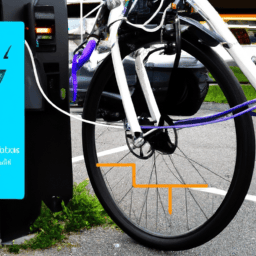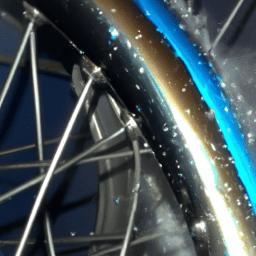As someone who cycles, ensuring my safety is a top priority for me. A crucial piece of safety gear for me is my bike helmet. It safeguards my head against severe injuries should I find myself in an accident. However, I often wonder about the longevity of my helmet’s protective capabilities.
In this article, I’ll delve into the factors that affect the lifespan of a bicycle helmet and provide tips for maintaining and replacing it. Wearing a helmet is essential when cycling, whether you’re a seasoned pro or a beginner. It’s the most effective way to reduce the risk of head injury in case of a crash.
However, not all helmets are created equal, and even the best helmet will eventually wear out. That’s why it’s important to know how long your helmet will last and how to tell when it’s time to replace it. In this article, I’ll share with you everything you need to know about the lifespan of a bicycle helmet and how to ensure you’re always cycling with maximum protection.
Key Takeaways
- The lifespan of a helmet is affected by frequency of use, intensity of activity, and exposure to conditions.
- Helmet replacement is recommended every 3 to 5 years, but frequent usage patterns can shorten the lifespan.
- Avid cyclists who regularly engage in high-intensity rides should replace their helmets more frequently.
- Exposure to weather conditions such as rain, sun, and snow can impact the durability of a helmet.
Importance of Wearing a Bicycle Helmet
You’re risking serious injury or even death if you don’t wear a bicycle helmet, which is why it’s so important to always wear one. Helmet safety is a crucial part of cycling, as it can help prevent brain injuries in the event of a crash.
A bicycle helmet is designed to absorb the impact of a collision, distributing the force of the blow over a larger area of the head. Without a helmet, your skull would absorb all of the force, increasing the risk of a severe brain injury.
Brain injury prevention is not the only benefit of wearing a bicycle helmet. A helmet can also protect your face, scalp, and skull from cuts and bruises. It can also keep your head cool in hot weather and warm in cold weather. Wearing a helmet can also reduce wind noise, making it easier to hear traffic and other sounds around you.
Overall, wearing a bicycle helmet is a simple yet effective way to protect yourself while cycling. Factors affecting the lifespan of a helmet include regular inspections, proper storage, and impact damage.
Factors Affecting the Lifespan of a Helmet
When it comes to the lifespan of a bicycle helmet, there are three factors that must be considered: frequency of use, intensity of activity, and exposure to conditions.
As a frequent cyclist myself, I know firsthand how often helmets can be subjected to wear and tear. Additionally, the level of intensity in our rides and the harshness of the environment we cycle in can also impact the longevity of our helmets.
Understanding these factors can help us make informed decisions when it comes to replacing our helmets and ensuring our safety on the road.
Frequency of Use
If you’re a frequent rider, your helmet is bound to wear out sooner rather than later, so it’s important to keep an eye on its condition.
Helmet replacement is recommended every 3 to 5 years, but frequent usage patterns can shorten the lifespan of the helmet. The more you ride your bike, the more likely it is that your helmet will need to be replaced sooner.
Additionally, helmets can sustain damage from impacts, so it’s important to inspect your helmet regularly for any signs of damage. To ensure your helmet is in good condition, you should inspect it before every ride.
Check for cracks, dents, or any other damage that could compromise the helmet’s ability to protect your head. If you notice any signs of damage, it’s time to replace your helmet. It’s better to be safe than sorry, as a damaged helmet may not provide the protection you need in the event of an accident.
Moving forward, let’s take a look at how the intensity of activity can affect the lifespan of a helmet.
Intensity of Activity
The more intense your rides, the quicker your helmet will wear out, so it’s important to consider the level of activity when determining when to replace your helmet. Avid cyclists who regularly engage in high-intensity rides should replace their helmets more frequently than those who only take leisurely strolls. The reason for this is that high-intensity rides increase the amount of wear and tear on the helmet. As a result, the helmet’s protective features may become compromised, leaving the cyclist vulnerable to head injuries in the event of an accident.
Another factor to consider when discussing the intensity of activity is your fitness level. Cyclists who are in better shape are more likely to ride faster and longer, which can also contribute to the degradation of a helmet’s protective features. Additionally, the difficulty of the terrain can impact how often you should replace your helmet. Cyclists who frequently ride on rough terrain with lots of bumps and jolts may need to replace their helmets more frequently than those who ride on smooth surfaces.
In conclusion, the intensity of your rides, your fitness level, and the difficulty of the terrain are all important factors to consider when determining when to replace your helmet. Moving forward, let’s explore how exposure to conditions can also affect the lifespan of a cycling helmet.
Exposure to Conditions
Exposure to various weather conditions can significantly impact the durability of your cycling helmet. Helmets are designed to withstand impact from falls, but they also need to be weather-resistant to ensure they can protect your head over time. Rain, sun, and snow can all cause damage to a helmet, especially if it’s not stored properly.
To help you understand how weather can affect your helmet, take a look at the table below. It outlines the different types of weather conditions and how they can impact your helmet’s lifespan. Keep in mind that these are general guidelines, and your helmet may last longer or shorter depending on the specific conditions it’s exposed to and how well you care for it.
| Weather Condition | Impact on Helmet | Recommended Storage |
|---|---|---|
| Rain | Can weaken glue and padding | Store in a dry place |
| Sun | Can cause fading and weaken plastic | Store in a cool, shaded place |
| Snow/Ice | Can cause cracking and damage to foam | Store in a dry place |
Understanding helmet degradation is important for ensuring your safety while cycling. By being aware of the different factors that can impact your helmet’s lifespan, you can take steps to protect it and ensure it’s always in good condition.
Understanding Helmet Degradation
Helmet degradation can significantly affect the helmet’s ability to protect your head, so it’s important to know how to identify signs of wear and tear.
Helmet durability can vary depending on the materials used in manufacturing. For example, polycarbonate helmets are more susceptible to cracking than helmets made of fiberglass or carbon fiber.
The lifespan of a helmet can also be affected by exposure to UV rays, sweat, and chemicals. Over time, the materials can become brittle, lose their shock-absorbing properties, and develop cracks or dents. Inspecting your helmet regularly for signs of wear and tear can help you determine when it’s time to replace it.
When a helmet is no longer able to provide adequate protection, it’s important to replace it promptly.
In the next section, we’ll discuss the recommended lifespan of a bicycle helmet and what factors can influence it.
Recommended Lifespan of a Bicycle Helmet
Understanding helmet degradation is an essential part of ensuring helmet safety. However, it is also crucial to know when to replace your helmet fully. According to helmet safety standards, a helmet should be replaced every five to ten years, depending on the manufacturer’s recommendations.
Factors such as usage, climate, and storage can affect the lifespan of a helmet. For example, a helmet exposed to prolonged sunlight or high temperatures can degrade faster than a helmet stored in a cool, dry place. Similarly, a helmet used daily or for long periods can wear out faster than a helmet used occasionally. It is essential to inspect your helmet regularly and replace it if you notice any visible signs of damage, such as cracks or dents. Proper helmet replacement is crucial to ensure maximum protection during a fall or collision.
| Factors | How They Affect Helmet Lifespan |
|---|---|
| Usage | A helmet used daily or for long periods can wear out faster than a helmet used occasionally. |
| Climate | A helmet exposed to prolonged sunlight or high temperatures can degrade faster than a helmet stored in a cool, dry place. |
| Storage | A helmet stored in a damp, humid environment can degrade faster than a helmet stored in a cool, dry place. |
| Impact | A helmet that has been involved in a collision or fall should be replaced, even if no visible damage is present. |
| Age | A helmet should be replaced every five to ten years, depending on the manufacturer’s recommendations. |
To ensure maximum protection when cycling, it is crucial to maintain and replace your helmet regularly. In the next section, we will discuss tips for maintaining and replacing your helmet to ensure its longevity and effectiveness.
Tips for Maintaining and Replacing Your Helmet
To ensure top-notch protection while cycling, it’s important to regularly maintain and replace your headgear. Here are a few tips to help keep your helmet in optimal condition:
-
Clean your helmet regularly: Use a mild soap and warm water to clean the interior and exterior of your helmet. Avoid using harsh chemicals or solvents as they can damage the helmet’s structure.
-
Proper storage: Store your helmet in a cool, dry place away from direct sunlight and extreme temperatures. Avoid hanging your helmet on handlebars or other protruding objects that can cause it to fall or become damaged.
-
Replace your helmet after impact: Even if your helmet appears to be undamaged after a fall or collision, it may have sustained internal damage. It’s recommended to replace your helmet after any impact to ensure continued protection.
-
Replace your helmet every few years: Over time, a helmet’s materials can deteriorate and lose their ability to protect your head. It’s recommended to replace your helmet every three to five years, even if it appears to be in good condition.
By following these tips, you can help ensure that your helmet provides the best protection possible while cycling. Remember, your helmet is one of the most important pieces of cycling gear you own, so take care of it!
Frequently Asked Questions
Can a helmet still offer protection even if it is beyond its recommended lifespan?
I would not recommend using a helmet beyond its recommended lifespan, as it may not offer adequate protection. Extending the lifespan of a helmet is not recommended, as it may not pass safety testing.
Can you repair a damaged helmet instead of replacing it?
When a helmet is damaged, it should be replaced immediately. Attempting a DIY fix can compromise the helmet’s integrity and reduce its effectiveness. Helmet repair options are limited, and it is best to err on the side of caution and replace the helmet.
Is it safe to buy a used helmet?
I do not recommend buying used helmets due to safety concerns. You cannot guarantee the helmet’s history, and it may have suffered damage or wear and tear. Also, helmet hygiene, proper cleaning, and maintenance are important for safety.
How can I tell when my helmet needs to be replaced?
When it comes to checking the lifespan of a bicycle helmet, inspection techniques are key. Look for cracks, dents, or any signs of wear and tear. Safety is paramount, so don’t hesitate to replace your helmet when needed.
Are all bicycle helmets created equal in terms of durability and lifespan?
Not all bicycle helmets are created equal in terms of durability and lifespan. Factors such as helmet materials and design can greatly impact its ability to withstand impact and protect the wearer.
Conclusion
In conclusion, a bicycle helmet is a crucial piece of safety equipment that can save your life in the event of an accident. However, it’s important to understand that helmets have a limited lifespan and can degrade over time due to various factors such as exposure to sunlight, sweat, and impact.
To ensure maximum protection, it’s recommended to replace your helmet every 3-5 years or after a significant impact. Remember, a helmet is like a shield that protects your head from harm, and just like any shield, it can become worn and ineffective over time.
So, take care of your helmet, inspect it regularly, and replace it when necessary to ensure that you’re always riding with the best protection possible.
Stay safe out there!









